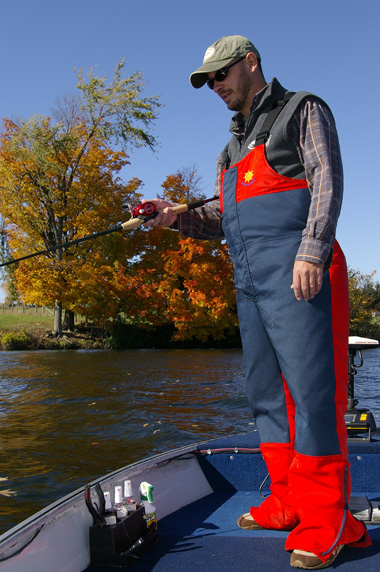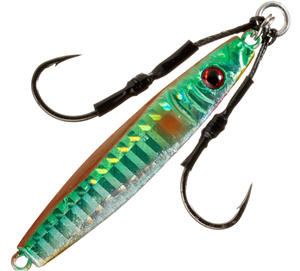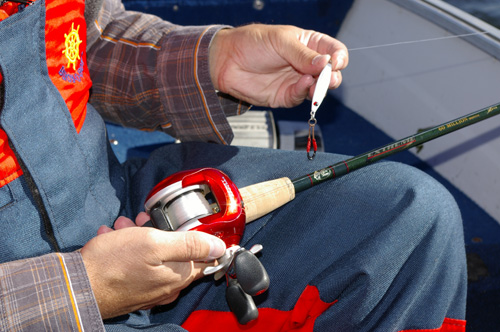
Fishing and working a weight-laden jigging spoon can score hefty fish from the hidden depths, yet it can also put a heavy strain on forearms, wrists and shoulders. Lures can also be shaken free from hooked mouths, especially when tangling with thrashing, acrobatic and head-shaking smallies. Don't get me wrong — this old school system can definitely catch fish. But I wondered: could there be a better "mousetrap" available for the jigging spoon enthusiast?
 |
| Freestyle rods offer direct contact with the rod blank, allowing you to feel every bump, hit or fouled hook. |
The Freestyle Jig Fishing Concept
The art of the freestyle jig fishing technique was brought to North America by the anglers of Japan where the concept originated. Simply put — they wanted a rod that would alleviate the strain put on the forearm that occurs with traditionally designed jigging rods, grouped with a jig that produces a higher hooking ratio. And — voila! — the freestyle revolution was born.
This is one system I needed to put through its paces.
At first glance the rod looks quite ordinary. But the real meat and potatoes of this apparatus can be found in the butt section. Similar in nature to the trigger handle of a flipping stick, the freestyle rod has an extendable butt end that can be shortened or elongated with a simple twist. "Why," you may ask? Herein lies the secret of the system.
The butt end of a freestyle jigging rod is to be tucked up tight and under the shoulder. Depending on how stocky your body is or the length of your arms, adjustments can be made until you get the most comfortable fit. Where in the past you relied on your wrist or forearms to give action to a spoon, this new system imparts jigging motion simply through the action of your body — mainly shoulder and arm working in unison. Not only is it less stressful to jig a spoon this way, but you also have direct contact with the blank, allowing you to feel every line bump, hit or fouled hook. Hook sets are more easily accomplished with this posture, and the leverage your body can generate by bypassing the forearm is phenomenal.
The rod itself is light and powerful, with some give in the tip end for those bone-jarring hits that are common during vertical jigging situations. At first use, I was amazed at the broader range of motion I could achieve in my jigging, all without the exaggerated forearm exercises I was used to performing.
 |
| Bass Pro Shops XPS Freestyle Jig |
Of course, the freestyle rod can be worked in conjunction with any vertical spoon and still produce great results. In fact, for those situations that don't call for a freestyle jig, this stick definitely gets the nod.
Freestyle jigs bring an interesting design to the vertical spoon market. Long, thin and pointy at both ends, the Bass Pro Shops XPS Freestyle Jig offers a lot of flash in five different color patterns. Although the spoon is a nice design, it is the pair of single-assist hooks that flare out from the top that make this jig a winner. Attached to the spoon by fishing braid, these two hooks offer supreme hooking and holding qualities. Separate hooking points make it harder for a fish to throw the bait. Think of it as a two-piece contraption instead of one. The jigs come in three different sizes: 1/2, 3/4 and 1 ounce.
Putting it All Together for Fishing Success
Although marketed as a largemouth and smallmouth system, I've also found success when plying the waters for Mister Oval Eyes. And having suffered the heartbreak of losing aerial smallies in the past, I must say, these new spoons certainly brought down the odds of that happening. The fishing hooks dug deep while allowing the rod to do the work — plain and simple.
 |
| Attach your fishing line to the split ring holding the assist hooks. |
Working a freestyle jig is unchanged from other spoons. Lift-drop-pause seems to work best, but if fish are on the feed, don't be afraid to get aggressive with your lifts. Most fish will hit on the pause or the flutter, so be prepared to drive the hooks home on the slightest tick or feeling of weightlessness. Then again, many fish will annihilate a jigging spoon, leaving no doubt in your mind that they are there.
In terms of working the fishing rod, it does take a brief learning curve to get used to. After working a jig with the forearm for so long, the change felt awkward at first, but soon felt extremely comfortable. It is surprising how little motion can affect the action of a jigging spoon, and I had to relay that to my body on my first outing. Hook sets were easier to achieve, and having the butt end under your shoulder made the task at hand much simpler.
Braid is recommended when working any type of vertical spoon, as the vibrations and action can be better felt, and the lack of line stretch can create more positive hook sets. A fluorocarbon leader tied directly to the spoon will work best for clear water or heavily pressured fish.
The freestyle jigging system can bring a new dimension to your fishing game. I've enjoyed days of largies, sauger, walleye and smallmouth, and plan on experiencing many, many more.
Give the freestyle rod and jigs a try this coming season — you'll be glad you did.
- 8314 views

